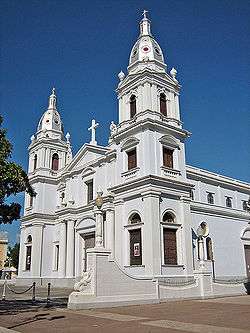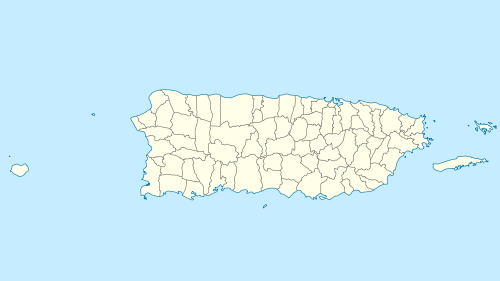Catedral de Nuestra Señora de Guadalupe
|
Catedral Nuestra Señora de Guadalupe of Ponce | |
 Front facade of Ponce Cathedral | |
 Location of Ponce and the cathedral in Puerto Rico | |
| Location |
Plaza Las Delicias Ponce, Puerto Rico |
|---|---|
| Coordinates | 18°00′43″N 66°36′50″W / 18.011839°N 66.613992°WCoordinates: 18°00′43″N 66°36′50″W / 18.011839°N 66.613992°W |
| Area | 2,960 m2 (31,900 sq ft) |
| Built | 1835 |
| Architect | Francisco Porrata Doria (1932 facade) |
| Architectural style | Neoclassical |
| MPS | 19th Century Civil Architecture in Ponce TR (AD) |
| NRHP Reference # | 84000467[1] |
| Added to NRHP | December 10, 1984 |
The Catedral de Nuestra Señora de Guadalupe (English: Cathedral of Our Lady of Guadalupe) or simply, Ponce Cathedral, is the cathedral for the Roman Catholic Diocese of Ponce located in downtown Ponce, Puerto Rico. The cathedral lies in the middle of Ponce's town square, known as Plaza Las Delicias, located at the center of the Ponce Historic Zone. For its historic significance, the cathedral was listed on the National Register of Historic Places in 1984.[1] It is the seat of the Bishop of Ponce, currently Rubén González Medina.[2][3]
The cathedral has a history that dates to 1670. It has been damaged several times by fires and earthquakes. It stands out among Puerto Rico's other four cathedrals for its intricate design. It has a large pipe organ that was played by danza master and composer Juan Morel Campos. Architecturally, it is designed in the neoclassical style. Structurally, it follows a cruciform plan, with a large dome at the crossing. The interior consists of a main nave and two large ailes separated by a series of eight arcades. There are two small chapels in its interior. Two three-story square towers decorate the front facade.
History
The cathedral has over 300 years of history. In 1670, a small chapel was built in the center of the colonial settlement of Ponce on the site of the present cathedral.[4] On September 17, 1692, the King of Spain, Carlos II, issued a Cédula Real (Royal Permit) designating the chapel as a parish church.[5] In 1835, the original parish church was demolished to build a larger church, which was completed and opened for worship in 1839.[1] Amongst its new features were two octagonal towers on the corners of the front facade. The original (pre-1918) towers were also three stories high and had windows on each of the sides. They were each topped with a Christian cross. The cathedral contains a number of burials within its interior.

The building was damaged by several fires and earthquakes during the 19th and 20th centuries including the 1918 Puerto Rico earthquake, which caused extensive damage, including the destruction of both of the original towers.[6] Despite this, the 1839 building forms the core of the present building, which Pope Pius XI declared a cathedral in 1924. The cathedral's first bishop was Edwin Byrne, who took charge in 1925.[7]
From 1931 to 1937, the church was reconstructed to a design by architect Francisco Porrata Doria.[8] The current facade bears a French neoclassical style. Among these improvements were the addition of two new chapels, a new roof, the remodelling of the upper storey of the facade and the construction of two new, richly-decorated square towers. A pipe organ was installed in 1934 and re-inaugurated in 1989 after a nine-year restoration.[6] The building was dedicated by Bishop James E. McManus on April 11, 1950.[9]
Location

The cathedral sits in the center of Ponce's central square, Plaza Las Delicias, oriented east-to-west, with its front entrance facing west. Immediately behind the cathedral, to the east, is the historic fire house, Parque de Bombas. The two buildings effectively divide Plaza Las Delicias into two smaller plazas, named Plaza Muñoz Rivera and Plaza Degetau. Low undulating walls line the cathedral's northern and southern sides, and serve to separate it from the Plazas.[1] Plaza Las Delicias is in barrio Segundo, one of the six core barrios of Ponce that compose Historic Zone designated by the Government of Puerto Rico to preserve the colonial character of the city.[10][11]
The building
The building's exterior architecture is Neoclassical, while its interior is mostly colonial and Gothic.[9] The current structure is larger than the 1839 structure, having been extended on the south side in 1911 with the addition of the side chapel. It covers an area of 3,540 square yards (2,960 m2).[1] The architecture of the cathedral is neoclassical in style with the exterior painted pale blue and gray and the interior in blue and beige.[12] The building has many stained glass windows depicting religious scenes and two bell towers.[13]

Interior plan
The footprint of the cathedral is of a cruciform plan. It features a large dome at the crossing of the transept and the nave. The interior consists of eight bays plus the apse. The westernmost bay accommodates the vestibule. Above this vestibule is a second level choir loft, accessible via a wooden stairway connected to the front wall. A large pipe organ, said to have been played by Juan Morel Campos every Sunday for many years, is also on this second level loft.[14]
Arcades of semi-circular arches divide the nave from the aisles. On the south side of the cathedral, a large chapel, built in 1911, extends three bays parallel to the aisle. This chapel provides a more intimate place of worship than the main church or its aisles. The nave has a cross vaulted ceiling with clerestory windows above the arcades. The cathedral's main neoclassical altar of translucent alabaster is a modern replacement for the original wooden gothic altar, now located in the southern side chapel.[7] The main altar, built in Burgos, Spain, was donated by the local Ferre family.[6][13] Except for the side chapel where terrazzo is used, the cathedral's floor is of gray and white marble design.[1]

The front facade
The western front facade is flanked by two square towers. They are both three stories high topped with silver domes and a Christian cross on top of these. Both towers have windows at each level. Access to the towers is through either of two small wooden doors located in the interior northwest and southwest corners of the church vestibule.[1]
Entry to the cathedral is through a tall pair of wooden doors in a style reminiscent of church doors of Middle Ages Europe. There are two round columns to each side of these doors, as well as rectangular wooden windows to both sides. Atop the second level of the front facade there is a large triangular pediment, and on top of this pediment sits a Christian cross considerably larger than the two atop the tower domes. There are also two statues standing at each of the two lower ends of the large triangular pediment. Except for the wooden windows and doors, all elements on the front facade are of masonry construction.[1]
Events
On December 12, the Cathedral hosts the annual event known as "Las Mañanitas", named after the Mexican birthday song (English: "Early Mornings"), which is sung during a pre-dawn religious procession in the downtown area to celebrate the day of the Virgin of Guadalupe, the patron saint of Ponce. The event started in 1965.[15] After the procession candle bearers attend Holy Mass at the Cathedral at 5:00 am. Up to 10,000 people attend the event.[16] On December 24, there is also a midnight Mass known as Misa de Gallo (English: Rooster's Mass).
Hours
Except for the Las Mañanitas event, the cathedral is open Monday through Friday from 6:00 am to 12:30 pm, and Saturday and Sunday from 6:00 am to 12:00 pm and from 3:00 pm to 8:00 pm.[17]
See also
- List of Catholic cathedrals in the United States
- List of cathedrals in the United States
- Roman Catholic Diocese of Ponce
References
- 1 2 3 4 5 6 7 8 "Cathedral Nuestra Señora de Guadalupe of Ponce" (PDF). National Register of Historic Places Inventory. National Park Service. October 30, 1984. Retrieved December 14, 2010.
- ↑ Bishop Ruben Antonio González Medina, C.M.F. David M. Cheney. Catholic Hierarchy.org v3.1.2, 25 Jan 2016 (Data: 4 Feb 2016). Accessed 18 December 2016.
- ↑ Millán, Reinaldo (December 13, 2009). "Ponce sings ‘Las Mañanitas’ to its patron saint". Puerto Rico Daily Sun. San Juan, Puerto Rico. Retrieved December 19, 2010.
- ↑ Vazquez, Doris (1986). "Spain in Puerto Rico: Early Settlements". Yale-New Haven Teachers Institute. Retrieved December 5, 2010.
- ↑ "Carta del Rey al Gobernador de Puerto Rico" [King's Letter to the Governor of Puerto Rico]. Puerto Rico En Breve [Puerto Rico in Brief] (in Spanish). Retrieved December 5, 2010.
- 1 2 3 "Ponce Cathedral". TravelPonce.com. Retrieved December 9, 2010.
- 1 2 "Ponce: Nuestra Señora de la Guadalupe Cathedral". Puerto Rico Encyclopedia. San Juan, Puerto Rico: Fundacion Puertorriqueña para las Humanidades. Retrieved December 5, 2010.
- ↑ "Banco Credito y Ahorro Ponceno" (PDF). National Register of Historic Places Inventory. National Park Service. April 27, 1987. Retrieved December 19, 2010.
- 1 2 Ponce: Ciudad Señorial -- Atracciones Turisticas. Archived 2013-01-17 at Archive.is Catedral Nuestra Señora de Guadalupe. Retrieved January 7, 2011.
- ↑ "Executive Order Number 72". microjuris.com. November 17, 2005. Retrieved December 3, 2010.
- ↑ "Ponce". Welcome to Puerto Rico. Retrieved December 3, 2010.
- ↑ Pariser, Harry S. (2002). Explore Puerto Rico (Fifth ed.). San Francisco: Manatee Press. p. 242. ISBN 1-893643-52-2. Retrieved December 19, 2010.
- 1 2 "Catedral Nuestra Señora de Guadalupe" [Cathedral of Our Lady of Guadalupe]. Ponce Ciudad Señorial: Atraciones Turisticas [Ponce, Lordly City: Tourist Attractions] (in Spanish). Municipio de Ponce. 2010. Retrieved December 23, 2010.
- ↑ Rivera, Jose (2006). Roberto Sierra's Missa Latina: Musical Analysis and Historical Perspectives. Florida State University, College of Music. p. 16.
- ↑ "Las Mañanitas in Ponce". TravelPonce.com. Retrieved December 9, 2010.
- ↑ "Las Mañanitas de Ponce reúnen a 10,000 personas" [Ponce's Las Mañanitas attracts 10,000 people]. El Nuevo Día (in Spanish). Guaynabo, Puerto Rico. December 12, 2010. Archived from the original on December 15, 2010. Retrieved December 13, 2010.
- ↑ Porter, Darwin; Prince, Danforth (2009). Frommer's Puerto Rico. Hoboken, NJ: Wiley Publishing, Inc. p. 180. ISBN 978-0-471-78740-2. Retrieved December 23, 2010.
Further reading
- Marvel, Thomas S. and Moreno, Maria Luisa. Architecture of Parish: Churches in Puerto Rico. Rio Piedras, P.R.: Editorial Universitaria, unpublished.
- Historic Photographs, c.1910, Junghanns Collection, General Archives of Puerto Rico, San Juan, PR.
- U.S. Supreme Court: MUNICIPALITY OF PONCE v. ROMAN CATHOLIC APOSTOLIC CHURCH IN PORTO, 210 U.S. 296 (1908). 210 U.S. 296. MUNICIPALITY OF PONCE, Appt., v. ROMAN CATHOLIC APOSTOLIC CHURCH IN PORTO RICO. No. 143. Argued and Submitted March 3, 1908. Decided June 1, 1908. United States Supreme Court. Retrieved 29 September 2013.
External links
| Wikimedia Commons has media related to Ponce Cathedral. |
- Roman Catholic Diocese of Ponce (Official Site in Spanish)
- GCatholic page for Catedral Nuestra Señora de la Guadalupe
- "Las mañanitas" at Spanish wikisource.
- Postcard. Exterior of the Cathedral before the earthquake of 1918.
- 1940s Postcard. Interior of Ponce Cathedral showing the altar before the Ferré donation.
- Photo of Cathedral showing the towers before the 1918 earthquake.
- Interior of the Cathedral circa 1910.
- The Cathedral during its 1930s restoration
- Interior of the Cathedral in the 1940s
- Close up of the Cathedral's altar in the 1930s
- Plaza Las Delicias (Muñoz Rivera side) looking west c. 1908
- Youtube - Celebration of Las Mañanitas in Ponce, Puerto Rico
- Photos of the Cathedral in 1910 and 1984. Historic Churches of Puerto Rico. Puerto Rico State Historic Preservation Office and the Junghanns Collection, General Archives of P.R. c.1910. National Park Service, Listing Reference Number 84000467. December 10, 1984.
- Catedrales Catolicas del Mundo: Catedral de Ponce, Puerto Rico. (In Spanish. English title: Catholic Cathedrals of the World: Cathedral of Ponce, Puerto Rico.)